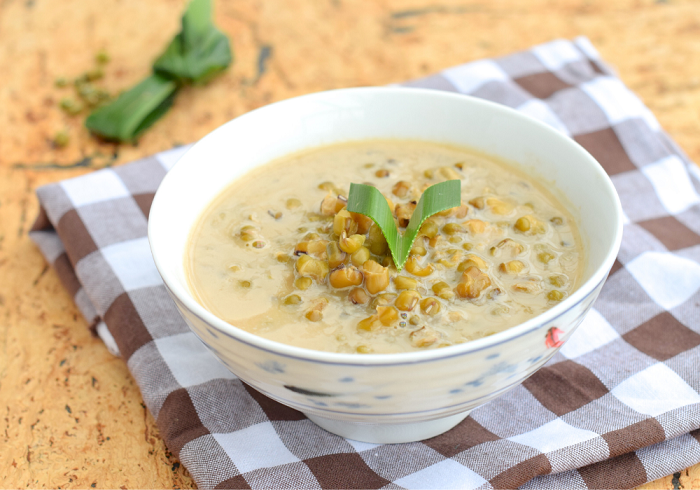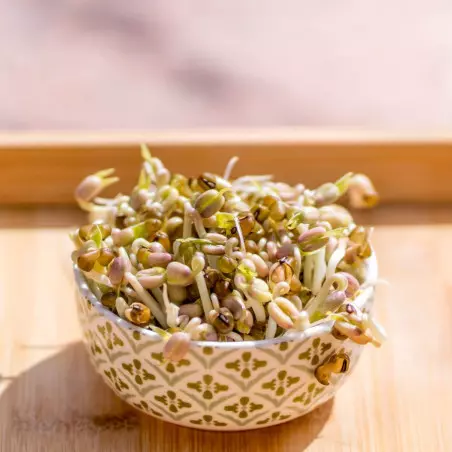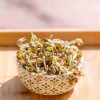Le The mung bean, also known as green soybeans or of black-eyed pea, is a popular legume in Asian cuisine. It comes from a tropical plant native to India belonging to the botanical family Fabaceae. Besides its pleasant taste, this plant has many nutritional qualities and offers many health benefits. In this article, we will explore the benefits of mung bean seeds and sprouts.
What is the difference between mung beans and soybean sprouts ?
Although mung beans and soybean sprouts are classified in the same family, Fabaceae, and are often confused, there are significant differences in terms of consumption methods, nutritional composition, and taste.
| Characteristic | Mung bean | Soybean sprouts |
| Scientific name | Vigna radiata | Glycine max |
| Edible part | Green seeds | Young shoots |
| Appearance | Small round and pale green seed | White and crunchy stem with green leaves |
| Taste | Slightly sweet and nutty | Sweet and crunchy |
| Texture | Closed | Crunchy |
| Common usage | Used in curries, soups, and vegetable dishes | Used in salads, sandwiches, and stir-fry dishes |
| Nutritional value | Rich in protein, a source of fiber, and B vitamins | Low in calories, rich in vitamins C and K, and in minerals |
What are the characteristics of the mung bean ?
Here are some characteristics of the mung bean:
Appearance: The mung bean has an oval shape and is pale green in color. The seeds are small, measuring about 3 to 5 mm in diameter.
Culture: This green seed comes from an annual plant that can be grown outdoors in warm and humid regions. It requires well-drained soil and a sunny exposure. It can be cultivated from seeds and reaches maturity after about 3 months.
Culinary use: The mung bean is used in many Asian cuisines. The seeds can be cooked and added to dishes such as soups, salads, stews, and curries. Mung bean sprouts can be eaten raw in salads or cooked in stir-fried dishes.
Mung bean sprouts: Mung bean sprouts are its seeds that have been soaked in water for a few hours to make them sprout. These sprouts contain a very high amount of fiber and are fat-free. Asians eat them for their numerous health benefits, such as improving eye health, bone health, and the immune system.
What are the nutritional values of mung beans ?
The mung bean is a legume rich in essential nutrients. Here are the nutritional values for 100 grams of raw mung beans:
Calories: 347 kcal
Proteins: 24.8 g
Lipids: 1.2 g
Carbohydrates: 63.4 g (including 14.2 g dietary fiber
Vitamin B1: 0.6 mg
Vitamin B2: 0.2 mg
Vitamin B3: 1.7 mg
Vitamin B5: 0.6 mg
Vitamin B6: 0.3 mg
Vitamin C: 4.8 mg
Vitamin K: 9.8 µg
Calcium: 132 mg
Iron: 6.7 mg
Magnesium: 189 mg
Phosphorus: 367 mg
Potassium: 1,435 mg
Zinc: 2.7 mg
Mung beans also contain antioxidants "and some" phytonutrients beneficial for health. Regular consumption of mung beans can help reduce the risk of chronic diseases such as heart disease, diabetes, and cancer.
6 benefits of mung beans:
The mung bean offers several health benefits. Here are some of the potential advantages of mung bean seeds and sprouts:
Nutrient richness: Mung beans are an excellent source of plant-based proteins, fiber, B vitamins, and minerals such as iron, magnesium, phosphorus, and potassium. Mung bean sprouts provide vitamins C and K.
Blood sugar control: Mung beans have a low glycemic index, which means they do not cause spikes in blood sugar levels after being consumed. Their consumption can help maintain stable blood sugar levels, making them an excellent food for diabetics.
Reduction of the risk of chronic diseases: Mung beans contain phytonutrients and antioxidants that may help reduce the risk of chronic diseases such as heart disease, diabetes, and cancer.
Digestion: Mung beans are a very good source of dietary fiber and have anti-inflammatory properties, which prevent gas buildup, improve digestion, and help prevent constipation.
Weight loss: Mung beans can be beneficial for weight loss because they help suppress ghrelin (a hormone that stimulates appetite). They are also characterized by their high dietary fiber content and low calorie content. They provide a feeling of fullness after a meal, thus helping to regulate body weight.
Skin health: Mung beans contain essential vitamins and minerals such as vitamin C and zinc, which can help maintain skin elasticity and strengthen it.
Where can one find mung beans ?
You can find mung beans in the natural food stores, ", the" Asian grocery stores "and the" supermarkets. Mung bean seeds are often sold in 500-gram bags or larger and can be found in the legumes or dry goods section. Mung bean sprouts are typically sold in trays or bags in the fruits and vegetables section.
It is also possible to grow mung beans yourself thanks to the organic sprouting seeds from BIOVIE, available on the site in packaging of 90g, 700g, or 5kg.
How to consume mung beans ?
The mung bean is well known in Asian cuisine and can be consumed in various ways. Here are some ideas and methods of preparation:
Cooked mung bean seeds: Mung bean seeds can be cooked and added to dishes such as soups, stews, and curries. They should be soaked for at least 4 hours before cooking to aid digestion and reduce cooking time.
Raw mung bean sprouts: Mung bean sprouts can be eaten raw in salads like spring rolls, or added to sandwiches or wraps.
Mung bean flour: This flour can be used to make bread, pancakes, galettes, pasta, and other pastries.
Mung bean noodles: Mung bean noodles are a healthy alternative to wheat or rice noodles. They can be used in soups, salads, stir-fries, or as a side dish for vegetable dishes.
Germination: Mung bean sprouts develop at room temperature. They are added to Asian recipes such as Chop Suey, which is a Chinese stir-fry dish where mung bean sprouts are cooked.

Can you eat mung beans raw ?
Raw mung beans can be consumed, but it is necessary to take precautions to avoid the risk of food poisoning. Raw mung beans contain lectins, which are proteins naturally present in certain legumes that can cause digestive problems if consumed in large quantities. Lectins are eliminated during the cooking or sprouting of mung beans.
If you wish to eat raw mung beans, it is advisable to soak them in water for at least 4 hours before eating to reduce the lectin content. However, it is always better to sprout or cook mung beans to avoid any risk of toxicity. Mung bean sprouts, as mentioned earlier, can be consumed raw without any risk.







